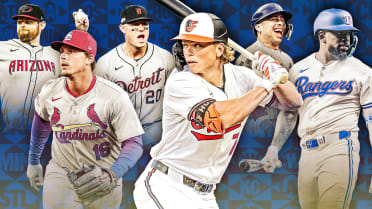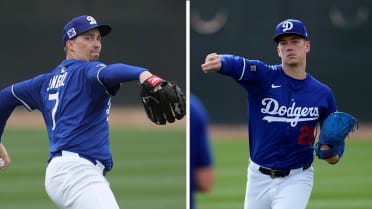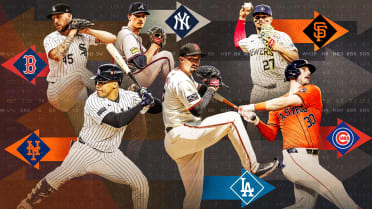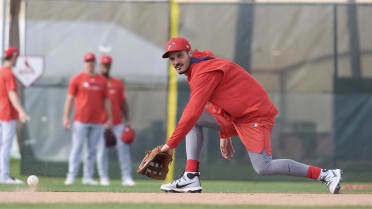Each team's best prospect in the past 15 years
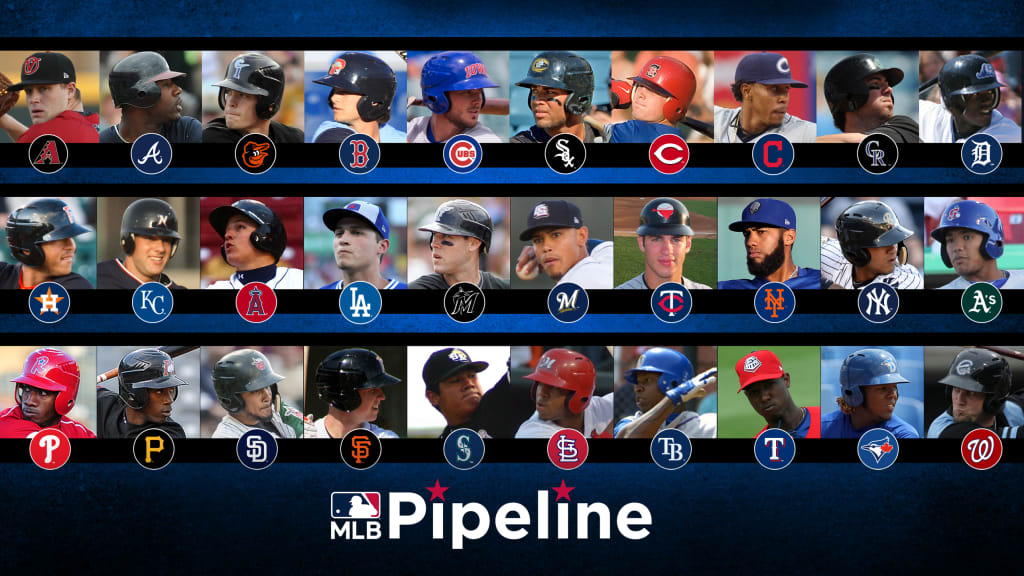
MLB Pipeline's new Top 100 Prospects list will be unveiled to the world on Saturday night on MLB Network and MLB.com with an hour-long special at 8 p.m. ET. It will be the 16th time MLB.com has assembled a preseason Top Prospects list, and the 10th time it has been revealed on the Network.
Some of the players on this year's list will go on to become among the greatest players in their organization's history. Others undoubtedly will not pan out. We won't know who those players are for quite some time, so for now, let's take a look back and see how teams' most highly touted prospects have fared.
Top Prospects lists archive
Below is a look at each Major League organization's most highly ranked prospect in the past 15 years.
Since we're only taking our preseason rankings into account here (we've also put out midseason lists in recent years), some notable names will be missing. Houston's Alex Bregman and Atlanta's Ronald Acuna Jr., for instance, ranked as baseball's No. 1 overall prospect during the 2016 and '18 seasons, respectively, but neither started the year at the top of the list.
And be sure that this year's rankings will add some new names to this "best of" list, as three teams will have a prospect ranked higher than they have on any of our previous lists.
Two teams, the Rays and Twins, have accounted for more than half of the No. 1 overall prospects in the last decade and a half, so picking just one player to focus on for those clubs wasn't easy. And while some teams have had more highly ranked prospects than others over the past 15 years -- the Rays have had the most Top 10 overall prospects (11), followed by the Braves, Dodgers and Nationals with 8 -- only one team, the A's, has not had a prospect rank among the Top 10.
American League East
:: Complete 2019 Top Prospects coverage ::
Orioles: Matt Wieters, C (No. 2, 2009)
Signed for $6 million as the No. 5 overall pick in 2007, the Georgia Tech product was ranked as baseball's best position-playing prospect two years later and quickly lived up to expectations with an impressive rookie season. He ultimately spent eight seasons in Baltimore, during which he was a four-time All-Star, a two-time Gold Glove winner and an 18.0-WAR player overall. Dylan Bundy gives the Orioles a second former No. 2 overall prospect (2013).
Red Sox: Andrew Benintendi, OF (No. 1 in 2017)
Three years after hitting one home run during an injury-marred freshman season at Arkansas, Benintendi ranked as the best prospect in baseball. In between, he won the NCAA Division I home run crown and the Golden Spikes Award in 2015, went seventh overall in the Draft, reached Boston 13 months after turning pro and posted an 1.111 OPS in the 2016 American League Division Series.
Yankees: Gleyber Torres, SS (No. 3 in 2017)
Torres had impressed with his advanced bat ever since signing with the Cubs for $1.7 million out of Venezuela in 2013, but he really raised his profile after Chicago made him the centerpiece of a trade for Albertin Chapman in July 2016. While the Cubs ended their World Series drought with Chapman, a 19-year-old Torres became the youngest MVP and batting champion (.403) in Arizona Fall League history.
Rays: Delmon Young, OF (No. 1, 2005-07)
Tampa Bay has had the No. 1 prospect in baseball five times in the last 15 years. Young, the No. 1 overall pick in the 2003 Draft, held that distinction for three straight seasons, the last of which saw him finish second in AL ROY voting at age 21. Though he never truly lived up to the high expectations ascribed to him as a top Draft pick, Young produced a .283/.316/.421 line with 109 homers over 10 seasons, and while he hasn't appeared in the big leagues since 2015, the now-33-year-old remains active and led the Venezuela Winter League with 19 home runs this offseason. David Price (No. 1, 2009) easily has been the most successful among Tampa Bay's former top-prospect contingent, and Matt Moore (2012) also had flashes of excellence early in his career.
Blue Jays: Vladimir Guerrero Jr., 3B (No. 1, 2018)
Guerrero is one of the best prospects we've ever seen, one with an elite combination of hitting ability -- he's the first ever to earn an 80-grade hit tool by MLB Pipeline -- and power that could make him a historically good big leaguer. He flirted with .400 for much of 2018, finishing at .381/.437/.636 with 20 homers in Triple-A at age 19. Altogether, he's compiled a .331/.414/.529 career line, with more walks (146) than strikeouts (135), since signing for $3.9 million in July '15.
AL Central
White Sox: Yoan Moncada, 2B (No. 2 in 2017)
Moncada was No. 2 on our Top 100 -- and on our Red Sox list behind Benintendi until going to the White Sox in a Winter Meetings trade for Chris Sale. Scouts considered him a faster version of Robinson Cano, though holes in Moncada's swing and an overly aggressive approach have prevented him from making that kind of impact in Chicago.
Indians: Francisco Lindor, SS (No. 4 in 2015)
We correctly pegged Lindor as a guy who would play Gold Glove defense, hit for a solid average and steal a few bases. He had just hit 19 homers and slugged .384 in four years in pro ball, so we graded his power a 40 on the 20-80 scouting scale, which now looks silly after he's coming off 33- and 38-homer seasons.
Tigers: Cameron Maybin, OF (No. 3, 2008)
Maybin reached the Majors as a 20-year-old in 2007 and was ranked as the No. 3 overall prospect that offseason when the Tigers sent him (in a package that also contained Andrew Miller) to Miami for Jose Cabrera and Dontrelle Willis. The trade marked the first of six in Maybin's 12-year career, during which he's been a 13.5-WAR player while playing for seven teams.
Royals: Alex Gordon, 3B (No. 2 in 2007)
Gordon was the No. 2 overall pick in that vaunted 2005 Draft, just behind Justin Upton, and was in the big leagues by 2007, when he was the No. 2 prospect behind Delmon Young. It took Gordon a while to find his footing in the big leagues, but he's a three-time All-Star and five-time Gold Glove winner in the outfield, leading a career WAR of 35.2, good for a tie at No. 41 on the career active WAR list.
Twins: Joe Mauer, C (No. 1 in 2004)
Mauer just hung 'em up, perhaps our first No. 1 prospect to do so after a long and successful big league career, which is why we give him the nod over two-time No. 1 prospect Byron Buxton. No, Mauer didn't produce in recent years like he did at the outset, when he looked like a sure-fire Hall of Famer, but he still retired with a career .306 average and more than 2,100 hits, adding up to a robust 55.1 WAR.
AL West
Astros: Carlos Correa, SS (No. 3 in 2015)
Though he missed the second half of the 2014 season with a broken right fibula, Correa already was exceeding expectations -- a rare feat for a No. 1 overall pick. He was a better pure hitter and better defender at shortstop than originally projected, which helped him jump from high Class A in 2014 to the American League Rookie of the Year Award in 2015.
Angels: Michael Trout, OF (No. 1 in 2011)
The Angels also had a No. 1 prospect in Shohei Ohtani a year ago, but this was about as close to a no-brainer as there is. Trout, of course, was the Angels' first-round pick in 2009, close to the end of the opening round. He's since made every team that didn't take him regret that decision. He currently is sixth on the career active WAR list (64.3) and is the only one in the top 24 with less than 10 years of big league time. He's made seven All-Star appearances, won six Silver Sluggers, two MVPs and a Rookie of the Year, and he's still just 27.
Athletics: Addison Russell (No. 12 in 2014)
The A's are the only organization that has never had a top 10 prospect, though Russell came in at No. 5 a year later, after he had been traded to the Cubs. He had gone to the Futures Game in 2013 and looked like he would join Correa and Corey Seager as high school shortstops from the 2012 Draft to become stars. He did help the Cubs win a World Series in 2016, but hasn't reached elite status.
Mariners: Felix Hernandez, RHP (No. 3 in 2005)
Before he became the King, Hernandez was the best pitching prospect in baseball, one who in retrospect should have ranked ahead of Delmon Young and Ian Stewart, who ranked first and second back in 2005. Hernandez graduated off of prospect lists that year, and his current 50.9 WAR puts him 16th on the career active list.
Rangers: Jurickson Profar, SS (No. 1 in 2013)
Profar either ranked as the No. 1 prospect or won MVP honors in each of the three Minor Leagues he played in before making his Major League debut as a teenager, and he looked like a future superstar with the chance for plus tools across the board as a shortstop. Then a torn shoulder muscle in 2014 led to two full seasons on the disabled list and kept him from becoming a big league regular until 2018, after which the Rangers traded him to the Athletics.
National League East
Braves: Jason Heyward, OF (No. 1 in 2010)
The No. 14 pick in the 2007 Draft, Heyward was the No. 3 prospect in 2009 then ascended to No. 1 a year later, ahead of Stephen Strasburg, Giancarlo (then Mike) Stanton and Buster Posey. While perhaps he hasn't quite lived up to that placement, he is in the top 50 among active players in WAR (34.9), ahead of Strasburg.
Marlins: Jeremy Hermida, OF (No. 2 in 2006)
The top high school hitter in the 2002 Draft, where he went No. 11 overall, Hermida elicited comparisons to Eric Chavez, Paul O'Neill and Andy Van Slyke at the plate. Though he arrived in the big leagues with a .284/.399/.433 Minor League batting line and hit a grand slam in his first plate appearance with the Marlins, his hitting and on-base numbers never translated to the highest level and his power never materialized.
Mets: Amed Rosario, SS (No. 5, 2017)
A breakout performance in 2016, during which he hit .341 after reaching Double-A at age 19, made Rosario a Top 10 prospect the following year, and he took over as the Mets' everyday shortstop that August. He underperformed last year in his first full season, slashing .256/.295/.381 over 154 games as a 22-year-old, but still showed loud tools and plenty of upside while producing 43 extra-base hits and 24 steals.
Phillies: Domonic Brown, OF (No. 4 in 2011)
The 2011 list started with Trout and had Jeremy Hellickson and Bryce Harper rounding out the top three. Brown was No. 4 and he never quite lived up to his potential, though he was an All-Star in 2013 during a season that saw him hit 27 homers. He played in the Mexican League in 2018.
Nationals: Bryce Harper, OF, Nationals (No. 2, 2012)
Possibly the most high-profile prospect in baseball history, Harper, the No. 1 overall pick in 2010, was No. 3 on MLB Pipeline's Top 50 the next year and one spot higher in '12, when he was named an NL All-Star and, later, the ROY at age 19. He added an MVP Award to his résumé in '15, and, overall, earned All-Star honors in six of his seven seasons as a 27.4-WAR player with the Nationals before hitting the open market at 26. Strasburg also reached the Majors in the same year he ranked as MLB Pipeline's No. 2 prospect (2010). He's been a 26.3-WAR hurler for the club over parts of nine seasons, during which he's twice been a Top 10 finisher in the Cy Young Award voting as well as a three-time All-Star.
NL Central
Cubs: Kristopher Bryant, 3B (No. 2 in 2015)
Bryant was the consensus college player of the year in 2013, when his 31 homers at San Diego exceeded the total of 223 of the 296 NCAA Division I teams, and the consensus Minor League player of the year in 2014, when he led the Minors with 43 homers, 78 extra-base hits, a .661 slugging percentage and 1.098 OPS. The next two years would bring National League Rookie of the Year and MVP awards, plus a World Series ring.
Reds: Jay Bruce, OF (No. 1 in 2008)
Bruce hit the top 10 in 2007, two years after being one of many high school outfielders (Upton, Maybin, Andrew McCutchen, Colby Rasmus) taken in the first round of the 2005 Draft. He was our No. 1 prospect in '08 after a year that saw him hit 26 homers and play across three levels of the Reds' system.
Brewers: Orlando Arcia, SS (No. 6, 2016)
The No. 88 overall prospect on Top 100 for 2015, Arcia jumped up to No. 6 on the list the following year and finished the season in the Major Leagues. He hit .277 with 15 homers as the Brewers' everyday shortstop in 2017, though early-season struggles in '18 prompted a demotion to Triple-A. He fared better after returning for good in late July, then served as Milwaukee's hottest hitter in the postseason, slashing .360/.385/.600 with a pair of home runs against the Dodgers in the NLCS.
Pirates: Andrew McCutchen, OF (No. 8 in 2008)
Based on WAR, no one has had a more productive big league career among the high school outfielders taken in the first round of the 2005 Draft than McCutchen's, whose 42.0 WAR bests everyone from that first round except Ryan Braun and Troy Tulowitzki, two college draftees. Having never ranked higher than this, the argument can be made that McCutchen was undervalued a bit as a prospect.
Cardinals: Oscar Taveras, OF (No. 3, 2013-14)
Taveras ranked as MLB Pipeline's No. 3 overall prospect in back-to-back years and was generally considered to be the sport's best offensive prospect during that time. He debuted with the Cardinals in May 2014, after hitting .320/.376/.516 over six season in the Minors, and ultimately appeared in 80 games as a rookie. Sadly, Taveras' promising career came to a tragic end that October when he was killed in a car accident in his native Dominican Republic.
NL West
Dbacks: Archie Bradley, RHP (No. 5, 2014)
Selected with the No. 7 overall pick in 2011 out of the Oklahoma prep ranks, Bradley was developed as a starter and reached the Majors in that role in 2015, one year after he had ranked as MLB Pipeline's top pitching prospect and No. 5 overall. While control problems subsequently forced Bradley to the bullpen, he's been a 4.1-WAR reliever in the past two seasons while logging 124 2/3 frames over 139 appearances.
Rockies: Ian Stewart, 3B (No. 2, 2005)
Stewart was the No. 10 overall pick in the 2003 Draft and had a huge first full year in Asheville with 30 homers and over 100 RBIs. While he did have one 25-homer season in the big leagues, he never quite lived up to the expectations set in that first season of pro ball, though he did hit 61 big league homers in just under 1,500 at-bats.
Dodgers: Corey Seager, SS (No. 1 in 2016)
Buxton had presided as the No. 1 prospect on five straight MLB Pipeline midseason or preseason Top 100s until Seager dethroned him at the start of 2016. He gave a preview of coming attractions by batting .337/.425/.561 during his September 2015 callup, foreshadowing the NL Rookie of the Year Award he'd win in 2016.
Padres: Fernando Tatis Jr., SS (No. 8, 2018)
Acquired from the White Sox as part of the James Shields trade in June 2016, Tatis advanced to full-season ball the next year and became the first 18-year-old in Class A Midwest League history to post at least 20 home runs and 20 stolen bases, before making the jump to Double-A in August. While season-ending thumb surgery in July 2018 cost him a second straight 20-20 campaign, Tatis did return healthy and excelled in the Dominican Winter League. Earlier this week, MLB Pipeline ranked Tatis as the No. 1 shortstop prospect in baseball.
Giants: Buster Posey, C (No. 4 in 2010)
The only player on this list to win a World Series in the same year that he peaked on the Top 100, Posey lived up to the Mauer comparisons that followed him everywhere. There were some mild concerns about his receiving but he cleaned those up and became a Gold Glover behind the plate.
